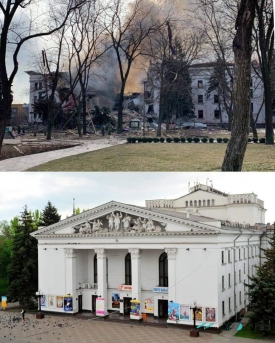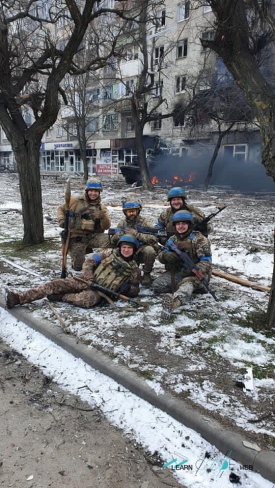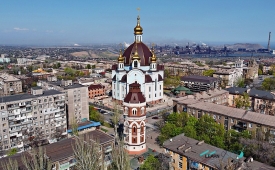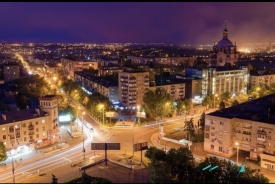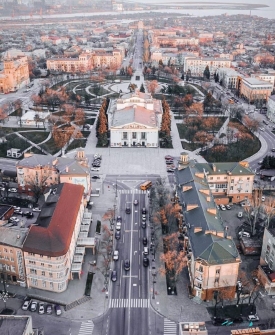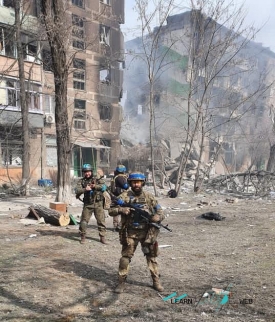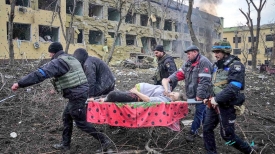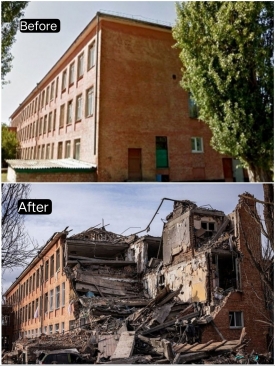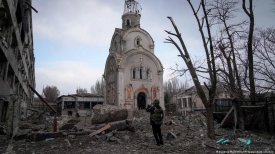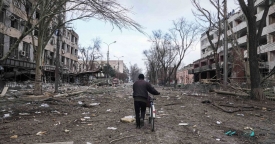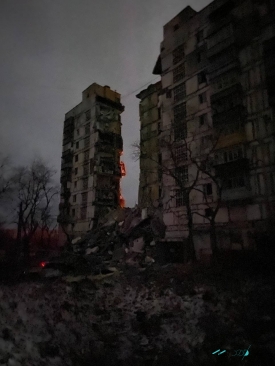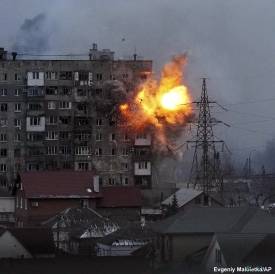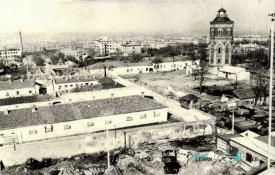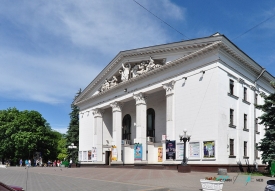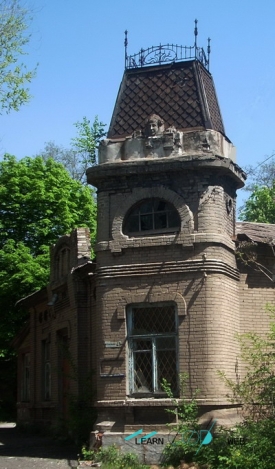Mariupol, named in the 16th century as Domakha, in 1778 as Pavlovsk; between 1948-1989 it was renamed Zhdanov. Located on the shores of the Sea of Azov, at the mouth of the Kalmius River. The population was 431,859 inhabitants until 2022.
March 6, 2022 Decree of the President of Ukraine to commemorate the feat, mass heroism and resistance of citizens who defended their cities during the rejection of the armed aggression of the Russian Federation against Ukraine, the city was awarded the honorary award "Hero City of Ukraine".
Important port and industrial center of the country. There are two large metallurgical plants in the city, the products of which make up a significant part of Ukraine's exports. In the industry of the Donetsk region Mariupol's share is 37.5%, in total Ukrainian industrial output is about 7%.
The modern settlement at the mouth of the Kalmius was founded in the 16th century by the Zaporozhian Cossacks as a guard post of trade and roads from the attacks of the Crimean Tatars. Thanks to the efforts of Colonel Andriy Porokhna, a stone church of St. Nicholas was built in 1754. That is, using the European traditions of that time, which linked the concept of a city to stone buildings, including temples, this year can be considered the foundation of the city. This is the opinion of the famous historian of Eastern Ukraine, Vasyl Pirko.
In 1776, the Kalmyk settlement was established on the site of the Domakha Cossack post. In 1777, the Church of St. Nicholas was founded in the Kalmius Fortress. In 1778 the county capital of Pavlovsk was founded near the settlement. Then it had 75 inhabitants, in total in the Habua village 93. That year is officially considered the date of formation of Mariupol. On May 21, 1779, Empress Catherine II presented a charter according to which "Immigrants from the Crimea were given privileges and freedoms." In the letter, the city was called "Marianopol", that is, the city of Maria. On March 24, 1780, at the insistence of Metropolitan Ignatius, the city was finally renamed Mariupol, after Maria Feodorovna, wife of Paul I. Some Greeks who arrived in July 1780 settled in the city, and most , around it. The Greeks gave the names of the Crimean settlements from which they came to each of their settlements. Thus the peoples of Bakhchisarai, Yalta, Urzuf, Sartana, Cherdakli, Karan, Mangush and others arose. Georgians and Vlachs founded the village of Ignativka.
The main occupation of the inhabitants of the merchant city was trade. On the seashore, on the outskirts of the city, there were up to 20 fish factories, which brought large profits to Mariupol merchants. In 1783, when the Crimean Khanate was annexed to the Russian Empire, some Greeks returned to their native lands. The vacated lands were given to new settlers and German colonies arose. In 1829 Cossacks who had returned from the Transdanubian Sich settled in the south-west of the county. They founded several villages (Nikolske, Boyove, etc.). In 1820 the resettlement of baptized Jews and Mennonite Germans was organized. In addition to the Greeks, Jews and Italians were allowed to settle in Mariupol. In 1807, Mariupol and 23 Greek towns were separated into a Greek district under the auspices of the Taganrog mayor's office and, from 1859, the Ekaterinoslav provincial government. In the 1840s, Slobodka was inhabited by retired soldiers and sailors.
In 1824, the Italian Cavalotti began building ships with a capacity of 135-160 tons in Mariupol. In 1840, pavers were laid from downtown to the stock exchange. In 1840 a stone embankment was built. Alexander I was in the city in June 1818 and in November 1825. In May 1820, the Russian poet Alexander Pushkin visited Mariupol during a trip from Ekaterinoslav to the Caucasus. In October 1837, the city was visited by Tsarevich Alexander Nikolaevich, the future Emperor Alexander II. Significant damage was inflicted on Mariupol during the Crimean War of 1853-1856. Maritime trade was suspended due to hostilities. In the spring of 1855, the Anglo-French squadron entered the Sea of Azov. On May 24, under cover of naval artillery, an Anglo-French landing party landed at Mariupol, destroying warehouses in the harbor and setting fire to several houses in the town.
With the beginning of the Russian aggression, Mariupol, due to its important strategic importance, became one of the key cities of the Russian-Ukrainian confrontation. Since April 13, 2014, the city was controlled by pro-Russian DNR terrorist groups. On June 13, 2014, the city was liberated from terrorists by battalions of Ukrainian volunteers, however, the city remains vulnerable to terrorist attacks, the largest of which occurred on January 24, 2015.
The Donetsk Regional State Administration was transferred to the liberated city, and in July the Donetsk Regional Department of the Ukrainian Ministry of Internal Affairs and the Donetsk Regional State Administration were relocated, thus making the city the center of the Donetsk region. . On August 14, a monument to Lenin was torn down in the city.
Since the beginning of March 2022, the city has been attacked again by Russian forces, maintaining a permanent blockade since then.
March 6, 2022 Decree of the President of Ukraine to commemorate the feat, mass heroism and resistance of citizens who defended their cities during the rejection of the armed aggression of the Russian Federation against Ukraine, the city was awarded the honorary award "Hero City of Ukraine".
Important port and industrial center of the country. There are two large metallurgical plants in the city, the products of which make up a significant part of Ukraine's exports. In the industry of the Donetsk region Mariupol's share is 37.5%, in total Ukrainian industrial output is about 7%.
The modern settlement at the mouth of the Kalmius was founded in the 16th century by the Zaporozhian Cossacks as a guard post of trade and roads from the attacks of the Crimean Tatars. Thanks to the efforts of Colonel Andriy Porokhna, a stone church of St. Nicholas was built in 1754. That is, using the European traditions of that time, which linked the concept of a city to stone buildings, including temples, this year can be considered the foundation of the city. This is the opinion of the famous historian of Eastern Ukraine, Vasyl Pirko.
In 1776, the Kalmyk settlement was established on the site of the Domakha Cossack post. In 1777, the Church of St. Nicholas was founded in the Kalmius Fortress. In 1778 the county capital of Pavlovsk was founded near the settlement. Then it had 75 inhabitants, in total in the Habua village 93. That year is officially considered the date of formation of Mariupol. On May 21, 1779, Empress Catherine II presented a charter according to which "Immigrants from the Crimea were given privileges and freedoms." In the letter, the city was called "Marianopol", that is, the city of Maria. On March 24, 1780, at the insistence of Metropolitan Ignatius, the city was finally renamed Mariupol, after Maria Feodorovna, wife of Paul I. Some Greeks who arrived in July 1780 settled in the city, and most , around it. The Greeks gave the names of the Crimean settlements from which they came to each of their settlements. Thus the peoples of Bakhchisarai, Yalta, Urzuf, Sartana, Cherdakli, Karan, Mangush and others arose. Georgians and Vlachs founded the village of Ignativka.
The main occupation of the inhabitants of the merchant city was trade. On the seashore, on the outskirts of the city, there were up to 20 fish factories, which brought large profits to Mariupol merchants. In 1783, when the Crimean Khanate was annexed to the Russian Empire, some Greeks returned to their native lands. The vacated lands were given to new settlers and German colonies arose. In 1829 Cossacks who had returned from the Transdanubian Sich settled in the south-west of the county. They founded several villages (Nikolske, Boyove, etc.). In 1820 the resettlement of baptized Jews and Mennonite Germans was organized. In addition to the Greeks, Jews and Italians were allowed to settle in Mariupol. In 1807, Mariupol and 23 Greek towns were separated into a Greek district under the auspices of the Taganrog mayor's office and, from 1859, the Ekaterinoslav provincial government. In the 1840s, Slobodka was inhabited by retired soldiers and sailors.
In 1824, the Italian Cavalotti began building ships with a capacity of 135-160 tons in Mariupol. In 1840, pavers were laid from downtown to the stock exchange. In 1840 a stone embankment was built. Alexander I was in the city in June 1818 and in November 1825. In May 1820, the Russian poet Alexander Pushkin visited Mariupol during a trip from Ekaterinoslav to the Caucasus. In October 1837, the city was visited by Tsarevich Alexander Nikolaevich, the future Emperor Alexander II. Significant damage was inflicted on Mariupol during the Crimean War of 1853-1856. Maritime trade was suspended due to hostilities. In the spring of 1855, the Anglo-French squadron entered the Sea of Azov. On May 24, under cover of naval artillery, an Anglo-French landing party landed at Mariupol, destroying warehouses in the harbor and setting fire to several houses in the town.
With the beginning of the Russian aggression, Mariupol, due to its important strategic importance, became one of the key cities of the Russian-Ukrainian confrontation. Since April 13, 2014, the city was controlled by pro-Russian DNR terrorist groups. On June 13, 2014, the city was liberated from terrorists by battalions of Ukrainian volunteers, however, the city remains vulnerable to terrorist attacks, the largest of which occurred on January 24, 2015.
The Donetsk Regional State Administration was transferred to the liberated city, and in July the Donetsk Regional Department of the Ukrainian Ministry of Internal Affairs and the Donetsk Regional State Administration were relocated, thus making the city the center of the Donetsk region. . On August 14, a monument to Lenin was torn down in the city.
Since the beginning of March 2022, the city has been attacked again by Russian forces, maintaining a permanent blockade since then.



